Bellflowers have characteristically bell-shaped, usually blue flowers, and many are cultivated as garden ornamentals. They are native mainly to northern temperate regions, Mediterranean areas, and tropical mountains. Blooming in shades of blue, purple, pink or white, Campanula (Bellflowers) are perfect for beds and borders, particularly in areas with cool summers. Whether annuals, herbaceous or evergreen perennials, they proudly display their bell or star-shaped flowers in late spring or summer and help create lovely combinations. Different types of Bellflowers include:
- Korean Bellflower
- Snake Head Fritillary
- Adriatic Bellflower
- Bluebell
- Peach-Leaved Bells
- Serbian Bellflower
- Dalmatian Bellflower
- Canterbury Bells
- Spotted bellflower
- Tussock bellflower
- Milky Bellflower
- Clustered Bellflower
- Viking Bellflower
- Foxglove
- Snowdrops
- Bells of Ireland
- Angel’s Trumpel
- Mountain Laurel
- Penstemon
- Alpine bellflower
- Bearded bellflower
- Italian Bellflower
- American Bellflower
- Pink Octopus Bellflower
Korean Bellflower

Korean Bellflower also referred to as Campanula takesimana is a vigorously-spreading bellflower variety with gracefully arching stems bearing long bell-shaped, drooping, satiny creamy-white flowers flushed with lilac-pink and adorned with dark speckles inside. Blooming from mid to late summer, the pendant flowers dangle above a lush foliage of large, heart-shaped, glossy, mid-green leaves. This interesting Bellflower is perfect as a groundcover or in areas where it will not overtake valued plants.
Snake Head Fritillary
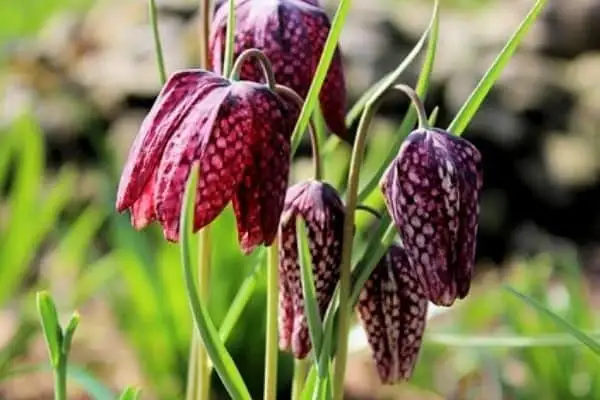
The snake’s head fritillary plant has lots of common names including chess flower, frog-cup and chequered lily. When in young growth, the flower buds are tightly encircled by the sheathing leaves, and together these poke vertically up through the grass like the nose of a small snake. As their stems elongate, so they arc over to ensure that the fertile bits within their dusky, nodding bells are protected from the rain. Its understated and architectural beauty is so graceful, and its design is so finely tuned for the environment in which it grows.
Also Read: Different Types of Jasmine Flowers
Adriatic Bellflower
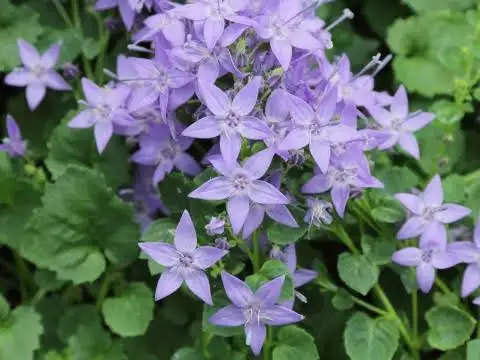
Adriatic Bellflower also referred to as Campanula fenestrellata is a low-growing, clump-forming bellflower variety forming a dense and attractive mound of bright golden-yellow, heart-shaped, toothed leaves. In late spring to early summer, loose clusters of starry, lavender-blue flowers bloom in such quantities that they nearly cover the entire plant. Evergreen in mild winter areas, this Adriatic Bellflower is perfect for border fronts, rock gardens or as a ground cover.
Bluebell
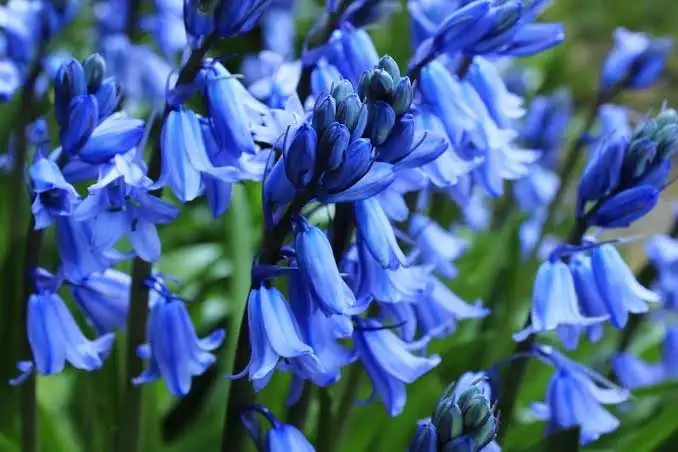
Bluebell is a perennial plant named for the shape of the flower which looks like a tiny bell. These flowers grow in clusters and are usually, but not always, blue as the name implies. Bluebells can be a creamy, off-white color. The cream-colored bluebell is rarely found in nature. This plant has long stems and narrow leaves. It grows to be 12 to 18 inches tall. The bluebell is easy to care for and spreads rapidly under the right conditions. This flower is a favorite of hummingbirds because of the shape of its blooms.
Peach-Leaved Bellflower

Peach-Leaved Bellflower also referred to as Campanula persicifolia is a clump-forming bellflower variety that sends up tall, sturdy stems which bear large, outward-facing, cup-shaped, single or double flowers in shades of violet-blue to white. Blooming over a long season, the enchanting flowers rise above spreading mats of narrow, toothed, bright green leaves. Adding color and contrast to the garden, these Bellflowers partner pleasingly with most perennials, including Baptisia australis (Wild Indigo), peonies or roses.
Also Read: Different Types of Peace Lily Flowers
Serbian Bellflower
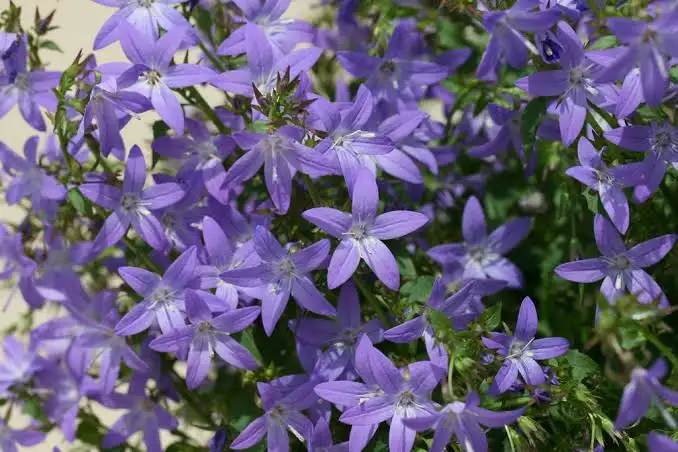
Serbian Bellflower also referred to as Campanula poscharskyana is a low-growing, sprawling bellflower variety forming mounds of flaring, star-shaped, pale violet-blue flowers, 1 inch across. Blooming freely from late spring to early summer, masses of flowers are borne on spreading stems above a foliage of rounded, mid-green leaves. Semi-evergreen to evergreen in warm winter climates, this Serbian Bellflower is perfect for edging paths or border fronts, cascading over walls or as a ground cover.
Dalmatian Bellflower
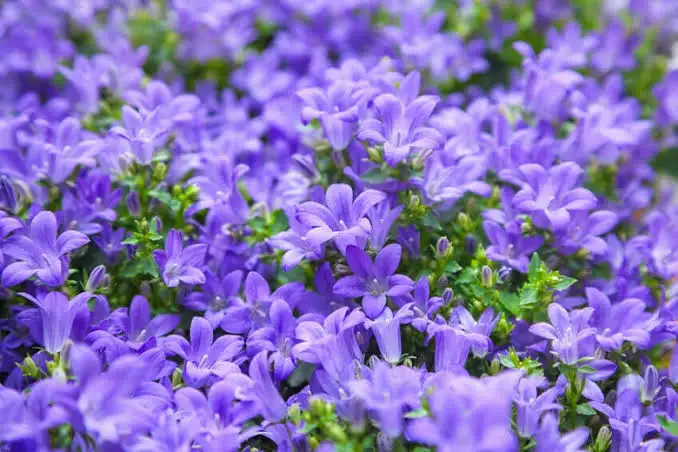
Dalmatian Bellflower also referred to as Campanula portenschlagiana is a very vigorous, low-growing bellflower variety forming evergreen mounds of flaring, bell-shaped, deep lavender flowers. Blooming freely in early to late summer, the abundant flowers are borne on branching stems above a spreading rosette of tiny, heart-shaped, mid-green leaves. This charming Dalmatian Bellflower is perfect for rock gardens, cascading over walls or raised beds. It will grow in crevices of a wall with a wonderful effect.
Canterbury Bells

Campanula medium, or “Canterbury Bells”, has a timeless charm and grace. Blooming in late spring to mid summer, the flowers are borne atop long leafy stems above a basal rosette of lance-shaped, dark green leaves. Masses of bells are in an astonishing range of blues, whites and pinks. Flowers appear all summer long and are from 60-90cm high. They will grow in almost any position whether sun or semi shade. Excellent source of nectar or pollen, they attract honey bees and butterflies. Old-fashioned but lovely, Canterbury Bells are well-suited to perennial borders and cottage gardens.
Also Read: Different Types of Lavender Flowers
Spotted bellflower

Campanula punctata also referred to as Spotted bellflower is an upright clump-forming bellflower variety with long, hanging pink rose or violet bells, adorned with creamy edges outside and purple freckles inside. Blooming from early to mid summer, the flowers are borne in terminal racemes atop erect to gracefully arching stems. They rise above basal rosettes of rounded, toothed, mid-green leaves. Loved by hummingbirds, this eye-catching Bellflower is perfect for rock gardens, cottage gardens and can spread quite rapidly into a dense groundcover.
Carpathian Bellflower
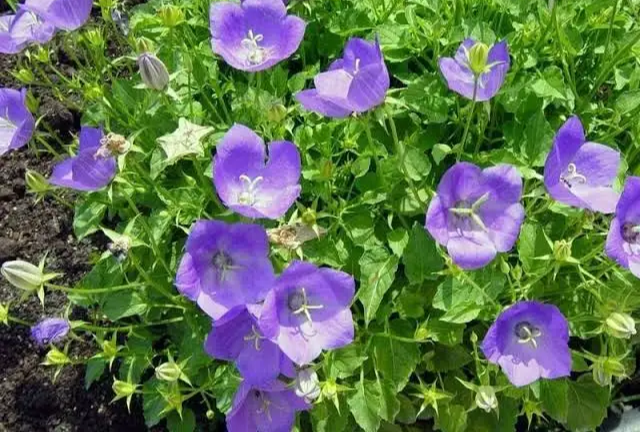
Campanula carpatica also referred to as Tussock or Carpathian Bellflower is a low-growing perennial with masses of large, upward-facing, bell-shaped flowers in shades of blue, purple or white over a long season. They are produced in such quantities that they nearly cover the entire plant. Flowering in early summer, Carpathian Bellflowers will continue blooming for weeks, until early fall, if spent blossoms are regularly deadheaded. Most of them can be grown in rock gardens, in wall crevices and in troughs. Some are wonderful at the front of perennial borders or massed as a groundcover.
Milky Bellflower

Milky Bellflower also referred to as Campanula lactiflora provides a stately presence in the garden with its tall, multi-branched stems producing hundreds of small lavender or white star-like flowers in open clusters from mid to late summer. Romantic looking, its long-lasting blooms mix superbly with roses and are spectacular additions to the perennial border, whether planted in sweeping drifts or used as a backdrop at the back of the border.
Clustered Bellflower

Clustered Bellflower also referred to as Campanula glomerata is a useful bellflower variety that brings early color and contrast to the garden. It features bouquets of eye-catching, violet-blue to white, upward facing, bell-shaped flowers, held in dense clusters. They sit atop sturdy leafy stems above basal rosettes of heart-shaped to oval green leaves. These clusters can have up to 15 flowers, therefore the common name of Clustered Bellflower. Blooming for 2-3 weeks from late spring to early summer, this spreading perennial does well in most soils.
Viking Bellflower
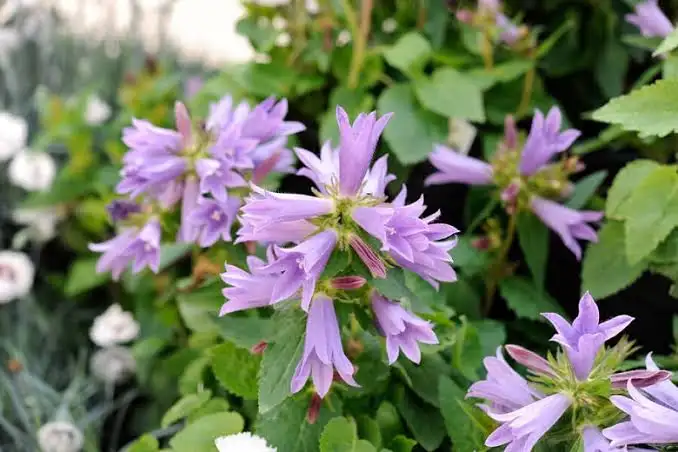
Viking Bellflower also known as the Campanula Viking, is a relatively recent hybrid that has become quite popular among gardeners. It is a mound-forming deciduous perennial with toothed and veined, ovate-shaped dark green leaves. Trumpet-shaped, lightly fragrant flowers, lilac to purple coloured, are borne on upright stems throughout the summer. Viking bellflower can be a spectacular additions to the perennial border, whether planted in sweeping drifts or used as a backdrop at the back of the border.
Also Read: Different Types of Salvia Flowers
Foxglove

Foxglove also referred to as Digitalis purpurea is often found in woodland areas. It typically grows as a biennial, appearing only as a basal rosette its first year before producing purple to white blooms on a flowering stem and going to seed the second year. Leaves are lance-shaped, ovate, soft, hairy and toothed. Flower spikes grow 3 to 6 feet tall and flowers look like thimbles, hanging down from the top of the spike. This Bell-shaped flower is perfect for edging paths or border fronts, cascading over walls or as a ground cover.
Snowdrops
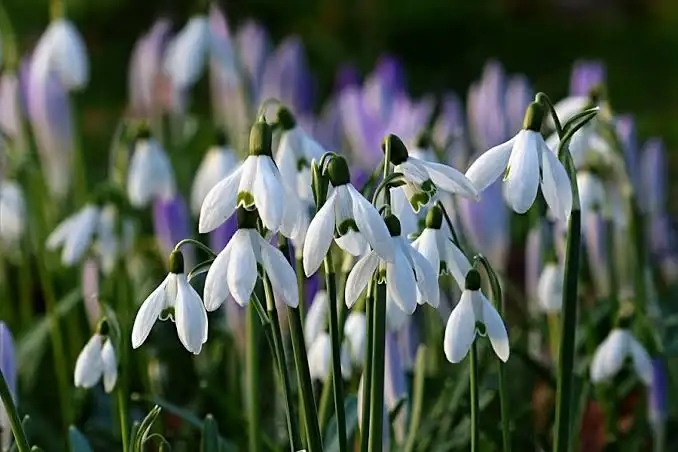
Snowdrops are tiny plants, 3 to 6 inches tall that produce one small, white, bell-shaped flower, which hangs off the end of a green, leafless stalk like a “drop” prior to opening. When the bloom opens, three outer petals arch out over three inner petals. The flower “nods its head” down to the ground. The grayish-green leaves are shaped like narrow blades, growing about 4 inches long. Its understated and architectural beauty is so graceful, and its design is so finely tuned for the environment in which it grows.
Bells of Ireland
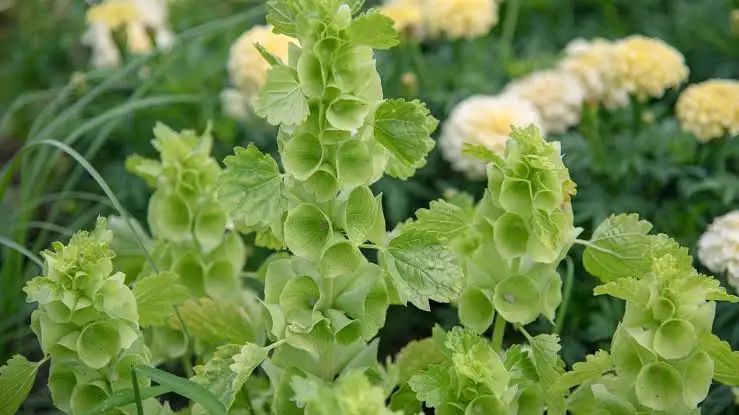
Bells of Ireland also referred to as Molucca balmis or shellflower plant. It grows well in cool climates and typically produces its inflorescences in late summer. The plant usually reaches 2–3 feet in height and bears toothed leaves on square thorny stems. The leafy flower spikes consists of cuplike green calyxes (fused sepals) surrounding small white fragrant corollas within. The flowers are two-lipped and tubular, typical of the mint family. Florists love bells of Ireland for its availability and longevity, and you’ll see it used in wedding flower arrangements as often as in St. Patrick’s day bouquets.
Angel Trumpet
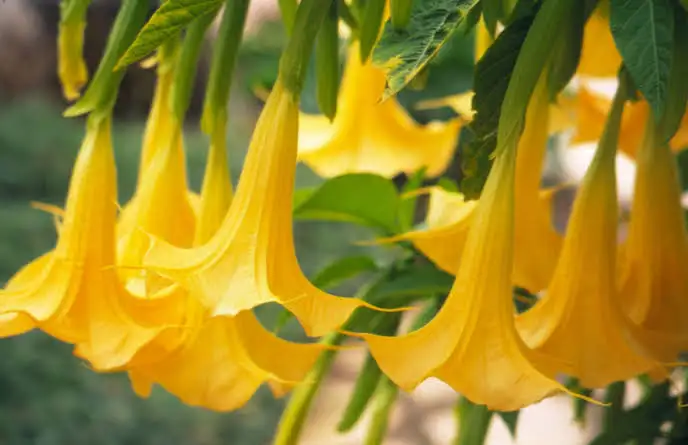
The angel trumpet flower (Brugmansia) is a tropical, tree-like plant that features large, pendulous flowers. The optimum size for angel trumpet plants is around 4-6 feet. The dangling, trumpet-shaped flowers bloom in shades of peach, yellow, white and red, and can reach lengths of 20 inches, depending on the cultivar. The broad, green leaves remain on the plant year-round unless there is a frost, in which case they may drop from the plant. It is a good flowering plant for mass plantings in shady shrub borders, woodland gardens, or for foundation plantings.
Mountain Laurel

Kalmia latifolia also referred to as the mountain laurel, calico-bush, or spoonwood usually grows as a dense, rounded shrub, with branches that grow gnarlier as the shrub ages. It has beautiful spring blooms, and its elliptical, glossy deep-green leaves (resembling those of rhododendrons) and gnarled stems make it attractive in all seasons. This shade-loving shrub produces clusters of rose, pink, or white flowers with purple markings.
Also Read: Different Types of Monstera Varieties
Penstemon
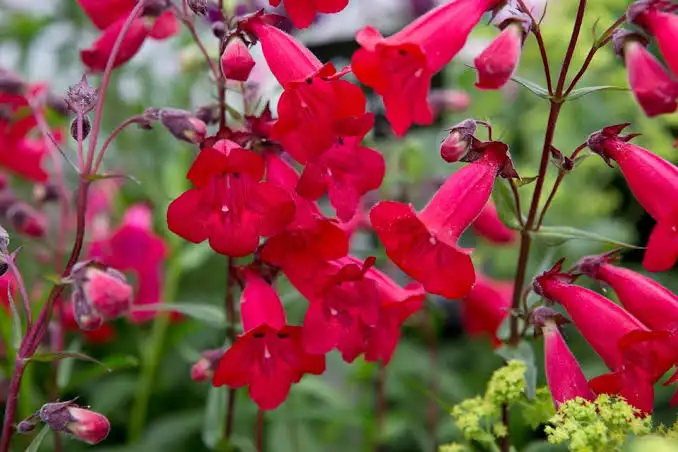
Penstemon plants are herbaceous perennials that feature lance-shaped foliage and spikes of tubular flowers. Flower colors include pink, red, white, purple, and (rarely) yellow. The nickname of beardtongue refers to the pollen-free stamen that protrudes from the flower, resembling a bearded iris in this aspect. It is a good flowering shrub for mass plantings in shady shrub borders, woodland gardens, or for foundation plantings.
Bearded Bellflower
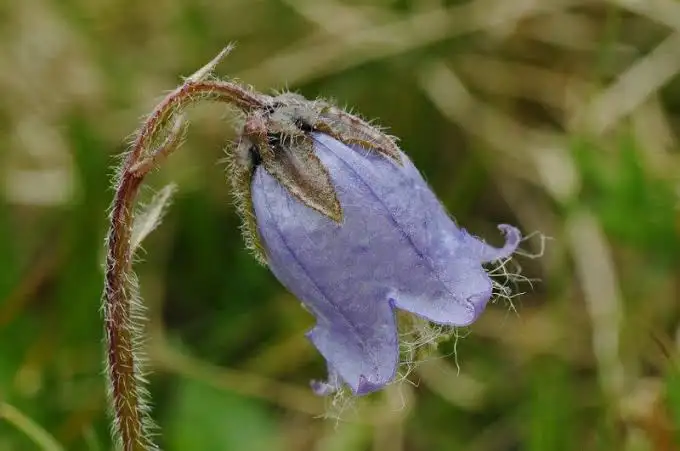
Bearded bellflower also referred to as campanula barbata can reach a height of 20–30 centimetres in hight. This plant produces a small basal rosette of grayish-green leaves, simple, lanceolate with dentate margins and alternate. It has racemes of nodding, pale blue to deep blue campanulate flowers, which are hairy inside (hence the Latin name barbata, meaning bearded). They bloom from June to August.
Italian Bellflower

Campanula isophylla also referred to as Italian bellflower is tender perennial, only marginally frost hardy and often grown as an annual or houseplant. Attractive to hummingbirds, each delicate blossom features a petal tube that elongates with age and a white ring at the throat. Italian Bellflower is a lovely addition to a woodland garden where it will self-seed readily, without becoming a nuisance, and keep a charming presence in the garden.
American Bellflower
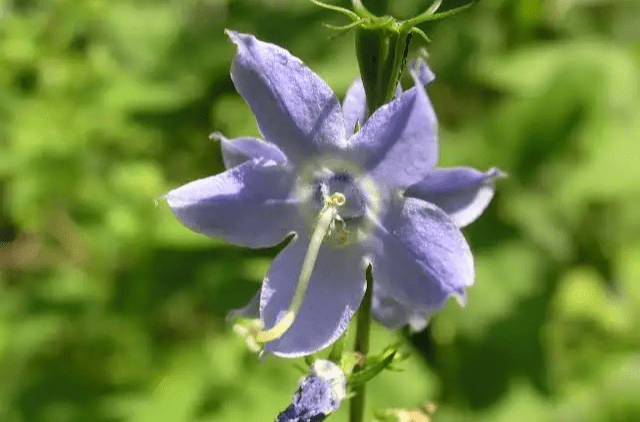
Campanulastrum americanum also referred to as American bellflower is bellflower variety with tall flower stems clad with rough, toothed, lance-shaped green leaves. In summer, the upper portion of the stem is studded with showy, flat, star-shaped, lavender-blue flowers. The flowers are borne singly or in clusters in the axils of the upper leaves. It produces foliage in the first year and flowers in the second year. American Bellflower is a lovely addition to a woodland garden where it will self-seed readily, without becoming a nuisance, and keep a charming presence in the garden.
Pink Octopus Bellflower

Campanula ‘Pink Octopus’ Commonly referred to as Pink Octopus Bellflower is a semi-evergreen and spreading perennial noted for its nodding, Japanese lantern buds opening in a striking, soft pink, octopus-like flower, with long and elegant spidery petals. Blooming from early to mid summer, the flowers are massed on upright stems, up to 50 per branch, above the deeply cut foliage. American bellflower is perfect for the front of sunny borders, containers or as a groundcover.
Further References
- Facts About Bellflowers: https://en.m.wikipedia.org/wiki/Campanula
- How To Care For Bellflowers: https://www.gardeningknowhow.com/ornamental/flowers/campanula/growing-campanula-bellflowers.htm
- Bellflowers: https://www.bhg.com/gardening/plant-dictionary/perennial/bellflower/
- Bellflower: https://www.britannica.com/plant/bellflower-plant
- Popular Campanula Varieties: https://www.thespruce.com/popular-campanula-species-5179243